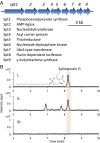Comparative transcriptomics as a guide to natural product discovery and biosynthetic gene cluster functionality
- PMID: 29229817
- PMCID: PMC5748202
- DOI: 10.1073/pnas.1714381115
Comparative transcriptomics as a guide to natural product discovery and biosynthetic gene cluster functionality
Abstract
Bacterial natural products remain an important source of new medicines. DNA sequencing has revealed that a majority of natural product biosynthetic gene clusters (BGCs) maintained in bacterial genomes have yet to be linked to the small molecules whose biosynthesis they encode. Efforts to discover the products of these orphan BGCs are driving the development of genome mining techniques based on the premise that many are transcriptionally silent during normal laboratory cultivation. Here, we employ comparative transcriptomics to assess BGC expression among four closely related strains of marine bacteria belonging to the genus Salinispora The results reveal that slightly more than half of the BGCs are expressed at levels that should facilitate product detection. By comparing the expression profiles of similar gene clusters in different strains, we identified regulatory genes whose inactivation appears linked to cluster silencing. The significance of these subtle differences between expressed and silent BGCs could not have been predicted a priori and was only revealed by comparative transcriptomics. Evidence for the conservation of silent clusters among a larger number of strains for which genome sequences are available suggests they may be under different regulatory control from the expressed forms or that silencing may represent an underappreciated mechanism of gene cluster evolution. Coupling gene expression and metabolomics data established a bioinformatic link between the salinipostins and their associated BGC, while genetic manipulation established the genetic basis for this series of compounds, which were previously unknown from Salinispora pacifica.
Keywords: Salinispora; biosynthetic gene cluster; specialized metabolism; transcriptomics.
Conflict of interest statement
The authors declare no conflict of interest.
Figures







References
-
- Harvey AL. Natural products in drug discovery. Drug Discov Today. 2008;13:894–901. - PubMed
Publication types
MeSH terms
Substances
Associated data
- Actions
- Actions
- Actions
- Actions
Grants and funding
LinkOut - more resources
Full Text Sources
Other Literature Sources
Molecular Biology Databases

